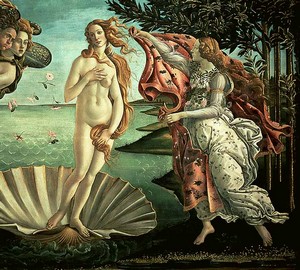
Description of the picture:
Birth of Venus – Sandro Botticelli. 1483-1485. Tempera on canvas. 172.5×278.5
The Birth of Venus, like “Spring”, the artist wrote for Lorenzo di Pierfranchesko Medici. The plot of this picture is based on the myth of how the goddess of love was born from the foam of the sea. Botticelli could find the exposition of the myth from ancient authors or its conversion from the poet Angelo Poliziano, who worked at the court.
Venus, standing in the sink, swims, driven by Zephyr and Chloride, and Ora, one of the goddess’s companions, who holds the veil to envelop her, goes to meet her. Fancy folds of bedspreads and clothes fluttering in the wind, waves at sea, a broken coastline, “corrugated” shell flap, and finally Venus’s flying hair – all this sets off the smooth contours of the body of the goddess and enhances the feeling of higher harmony that causes her appearance. The hands of the characters almost close above Venus’s head, and it seems as if it is overshadowed by an arch, which is echoed by the round bottom of the shell. Thus, the figure of the goddess is locked in an imaginary oval. If in “Spring” the composition consists of several groups that are equivalent in meaning, then here Venus is the center to which everyone strives.
Among Renaissance artists, the naked Venus, in contrast to the dressed, symbolized heavenly love. Botticelli endowed his heroine with that chastity, which is revered as the highest virtue, hence the worship motif present in the picture. The heroine’s beautiful face resembles the faces of Madonnas in Botticelli’s paintings, and therefore in this work the Christian theme sounds through the antique theme, and the combination of ancient humanism and Christianity gave the phenomenon of the Italian Renaissance."